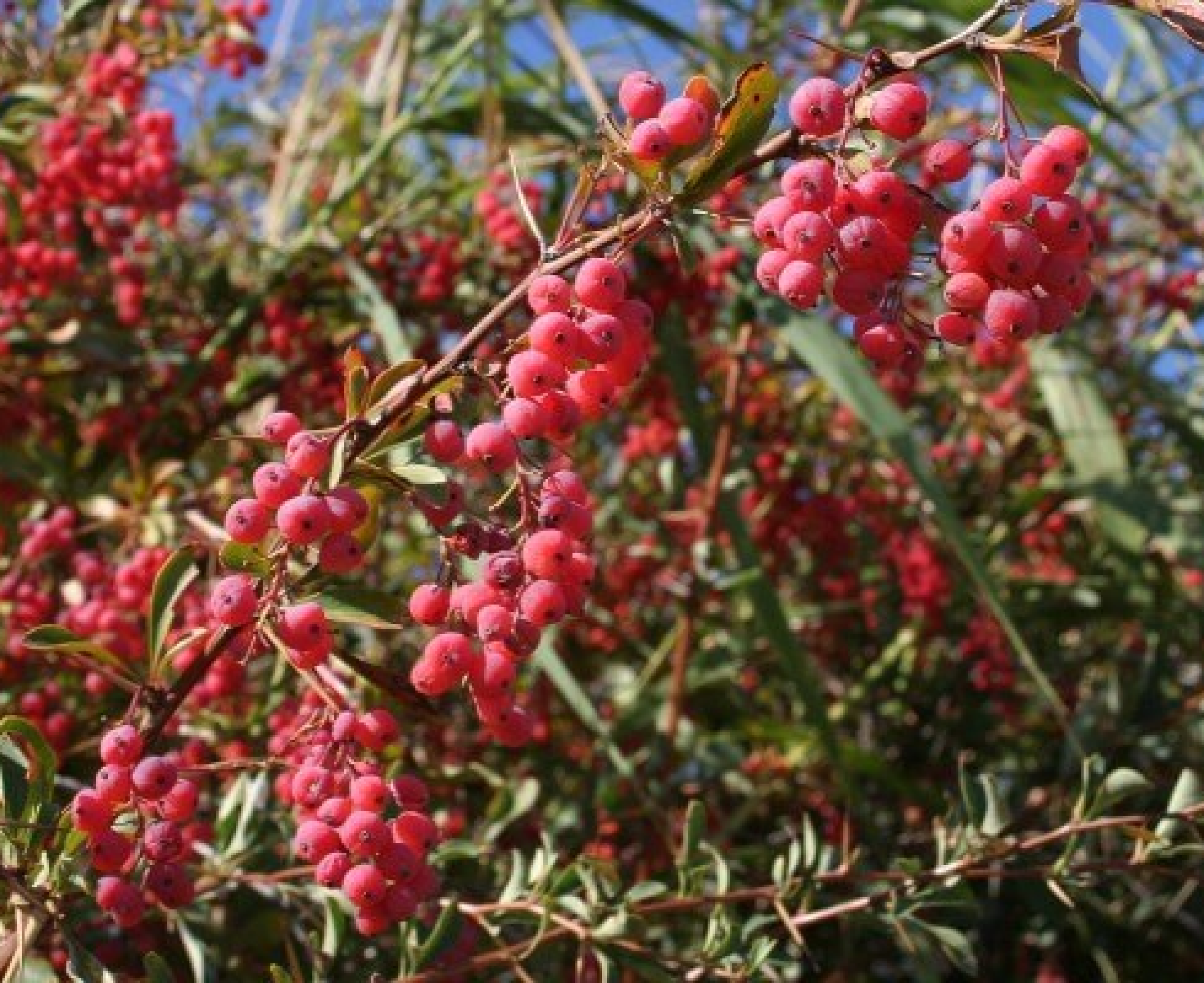
Ili
Barberry
Іле бөріқарақаты
Berberis iliensis M. Pop
Family:Berberidaceae
1
Distribution
It is endemic. It grows on clay and saline soils, on sands, among tugai vegetation.It is endemic to the Ili Valley. It is listed in the Red Book of Kazakhstan.
Status. A rare endemic species that occurs only in Kazakhstan, included in the Red Book of the Republic with the status of rare with a shrinking range.
The importance of the taxon in the preservation of the gene pool. An insufficiently studied species in systematic terms.
Botanical description. Branched, prickly shrub up to 3-4 m high; thorns on fruiting shoots are simple, on infertile — three-part, one—year-old branches are covered with multi-part thorns; leaves are leathery, smooth, lanceolate-lobed; inflorescence is an axillary multi-flowered brush; sepals are yellow, twice as short as obovate-prominent petals; fruits are pale red. The old branches are covered with gray bark, the annual ones are reddish-brown. Thorns are simple on fruiting shoots, 3- separate on infertile ones, and one-year-old branches are covered with multiparted, more often 5-6-separate thorns. The leaves are leathery, smooth, oblong- or lanceolate-lobed, entire on fruiting and awl—toothed on barren shoots, with a sharply protruding network of veins on the underside, stomata on the upper side of the leaf are absent, leaf blades 1.5—4.5 cm long, 0.6 – 2.2 cm wide, petiole 4-13-20 mm long. Inflorescence — axillary multi-flowered brush, 3-5 cm long, with 16-30 flowers. Bracts in number is 2, rounded-ovate, up to 1 mm long. The pedicels are 4-6 times larger than the bracts, the lower flowers are 4-7 (9) mm long, the upper ones, at the end of the brush, do not exceed 3-5 mm. The flowers are 3-4 (5) mm in diameter. The sepals are yellow, ovate, 2 times shorter than the petals. The petals are in number 3, inversely ovate, rounded-wavy along the upper edge, 4 mm long, 3 mm wide, nectary petals of the same shape as the petals, twice as narrow as the petals, 3-4 mm long, 2 mm wide. The pistil is barrel-shaped, with a discoid stigma up to 2 mm long, 3 ovules, rarely 2-4, on clear but short legs equal in length to a mature ovule. The fruits are pale red, oblong-ovate, about 6-7 mm long, 3-4 mm wide, darkening when dried [11].
Distribution. Kazakhstan: gorges in the eastern part of Zailiysky Alatau and Ketmen ridge, southern slopes of the Dzungarian Alatau, near the mouths of the Chilik, Charyn rivers flowing into the Ili River.
Habitats. Alluvial, argillaceous and alkali soils, among tugai thickets, on bumpy sands, pebbles, variegated outcrops, on rocks and gravelly slopes of hills no higher than 400-800 m above sea level, withstands strong salinization.
Using. It is of great interest to breeders, because it allows to create plant forms that can be used for landscaping white alkali and alkali. It is very decorative in flowering, fruiting and bright purple autumn color of leaves. Decorative durability of 30-40 years. It is recommended for hedges, single and group plantings in parks and squares.
The fruits of barberry are often used in cooking. They make excellent jams, compotes, juices, jellies and syrups. Well-dried and ground berries are used as a pleasant sour seasoning for meat dishes. Caucasian peoples add barberry during the preparation of kupaty and pilaf. Liqueurs and wines are made from sour berries. Slightly unripe barberry berries are salted and pickled. Barberry refers to honey plants. Bee honey from its pollen has a golden yellow color and a delicate taste. Barberry leaves are used in the manufacture of marinades.
In folk medicine, this plant is used as an anti-scurvy, choleretic, astringent, hemostatic, analgesic, antimicrobial, as well as for catarrhal diseases and conjunctivitis. A fatty oil with bactericidal properties is obtained from the seeds, used in the form of an emulsion ointment effective for dermatoses. From wood, bark and roots they get a wonderful, rather resistant paint, like gamboge. Berries, leaves, bark and roots of barberry are used to strengthen the heart muscle, with insufficient pancreatic function, diseases of the liver, spleen, bladder, as a hemostatic and anti-inflammatory agent. The fruits of barberry quench thirst well in feverish patients, stimulate appetite, have a mild laxative effect, enhance the secretion of gastric juice, improve digestion. In diseases of the liver and biliary tract, the infusion of leaves is used as an anti-inflammatory and choleretic agent. The plant contains seven alkaloids, including berberine. The leaves, bark and roots contain the alkaloid berberine, which reduces heartbeat and lowers blood pressure. With gastritis with low acidity, a drink from barberry berries helps well. Such a drink is also useful for strengthening the walls of capillaries. The fruits of barberry are used to improve appetite, quench thirst, as a diuretic, astringent, and also as a means to reduce temperature in feverish conditions. Infusion of barberry leaves is used for uterine contractions in the postpartum period, as well as for bleeding in obstetric and gynecological practice. Barberry root is recommended for enlargement of the liver and spleen, jaundice and hepatitis, inflammatory pimples, boils, conjunctivitis, fever.
